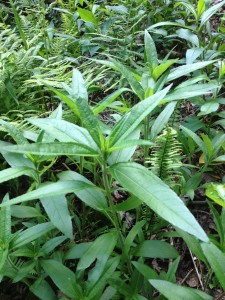Last year about this time I wrote about the Million Pollinator Garden Challenge. I hope at least some of you are also participating, either formally or simply by planting some nectar rich flowers and providing for wildlife in your landscape.
 High summer here in Birmingham brings sizzling heat and lots of it, along with the welcome abundance of life in pollinator gardens. In mine the perennial summer phlox, coreopsis, coneflowers, butterfly weed, salvias, rudbeckias, and daylilys are abuzz.
High summer here in Birmingham brings sizzling heat and lots of it, along with the welcome abundance of life in pollinator gardens. In mine the perennial summer phlox, coreopsis, coneflowers, butterfly weed, salvias, rudbeckias, and daylilys are abuzz.
Annuals, especially those in the sun, are also capturing bee, butterfly and hummingbird attention, and I try to plant a variety for each in my sunniest beds. Angelonia, gomphrena, zinnias, batface cuphea, Mexican heather, purslane, and more jockey for space.
 I take walks through my landscape early in the morning before leaving for work (And the heat builds.), deadheading, weeding, and simply admiring too.
I take walks through my landscape early in the morning before leaving for work (And the heat builds.), deadheading, weeding, and simply admiring too.
This is the tail end of daylily season, and on summer evenings I pull off unsightly yellow leaves, faded blooms that might be hanging on, and then cut spent scapes to the ground.
 After they’re completely through blooming, if foliage looks rough, I’ll grab a handful, twist it, and cut it completely off. It will reflush with more sightly looking leaves lasting until the end of the season. Remember, you see foliage more of the year than flowers on most perennials. Plan for that when deciding where to plant them or if you’re dividing and/or moving them.
After they’re completely through blooming, if foliage looks rough, I’ll grab a handful, twist it, and cut it completely off. It will reflush with more sightly looking leaves lasting until the end of the season. Remember, you see foliage more of the year than flowers on most perennials. Plan for that when deciding where to plant them or if you’re dividing and/or moving them.
If it’s been very dry, the early morning hours are spent watering any plants that look wilted. If they’re left without water too often, the stress will weaken them and they’ll be more susceptible to disease and insect attacks.
I’ve noticed some of the small white gomphrena that I planted quite late are struggling. I don’t think they’re getting enough sun, and they’ve gotten parched more than a few times. I’ll be keeping an eye on them.
 The summer phlox and coreopsis are in full bloom and the bees love them. I watch tiny skipper butterflys light on the coreopsis; they move so fast! When these two play out I’ll cut the faded flowers off the phlox and wait for a second, smaller display.
The summer phlox and coreopsis are in full bloom and the bees love them. I watch tiny skipper butterflys light on the coreopsis; they move so fast! When these two play out I’ll cut the faded flowers off the phlox and wait for a second, smaller display.
The coreopsis will be sheared back since there are too many small flowers and not enough hours in the day to deadhead each one.
As with most summer blooming perennials, I’ll cut stems back completely to neaten the garden and give late blooming plants room to shine when the weather finally cools.
 Honestly, though, it’s really too hot to do much more than water, deadhead, and pull opportunistic weeds that seem to come out of nowhere. Even as I water I’m dreaming of my vacation north to see family and friends. I know my garden will be here when I return, grown even more lush with high summer’s heat and, hopefully enough rain too.
Honestly, though, it’s really too hot to do much more than water, deadhead, and pull opportunistic weeds that seem to come out of nowhere. Even as I water I’m dreaming of my vacation north to see family and friends. I know my garden will be here when I return, grown even more lush with high summer’s heat and, hopefully enough rain too.
By Kris Blevons











